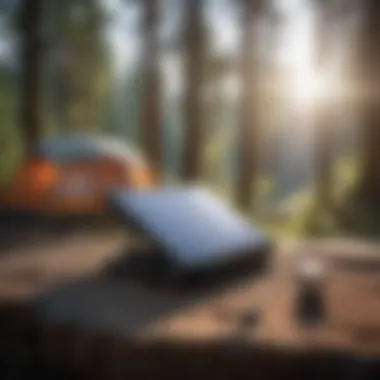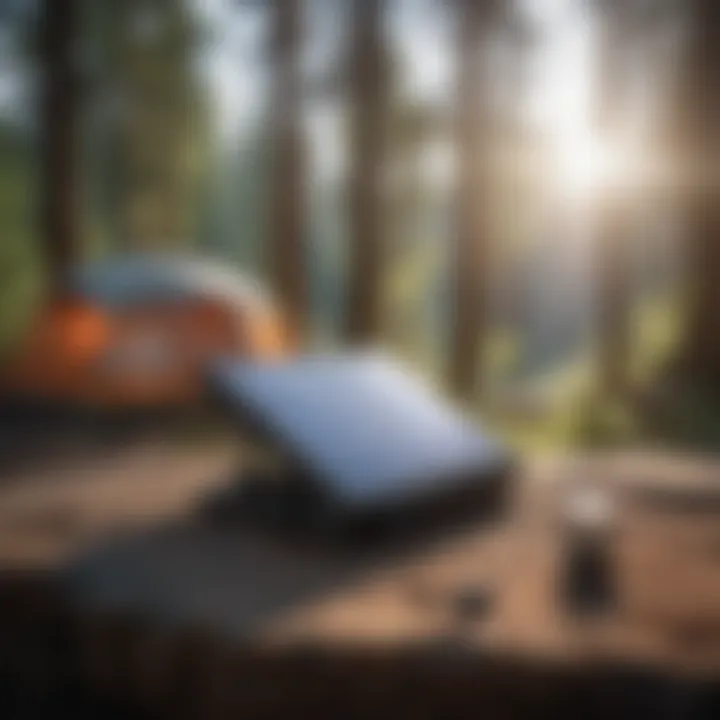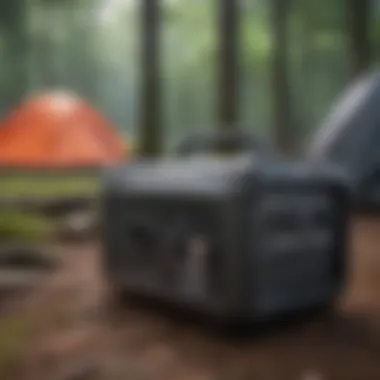Camping Power Solutions: Ultimate Guide for Adventurers


Intro
In the world of camping, having a reliable power source can make a significant difference in enhancing the outdoor experience. The modern adventurer often requires electricity for various purposes, ranging from charging devices to powering essential equipment. Relying solely on traditional camping methods limits the enjoyment and safety of one's time in nature.
As technology evolves, so do the options for camping power solutions. This guide aims to provide a comprehensive overview of these options, addressing their advantages, limitations, and practical applications. By understanding the diverse range of tools available, campers can make informed decisions that best suit their style and energy needs.
Power solutions can vary greatly in efficiency, portability, and cost. Each option has unique attributes that make it suitable for different camping scenarios. Whether it is a solo trip into the wilderness or a family camping adventure, understanding these solutions is crucial for any outdoor enthusiast.
From solar panels and portable generators to power banks and inverter systems, this guide will take an in-depth look at how to effectively harness power while in the great outdoors. Each section will provide detailed insights that highlight key features and real-world applications, ensuring readers walk away with the knowledge they need to enhance their camping experience.
Foreword to Camping Power Solutions
As outdoor adventures become increasingly popular, understanding reliable power solutions for camping is vital. It is no longer sufficient to unplug and escape the city; many campers seek the comforts of modern technology even while in nature. This is where camping power solutions become essential.
Reliable power sources enhance the camping experience by allowing for the use of various electronic devices. Campers can charge mobile phones, run small appliances, and even power lights. Moreover, these solutions can contribute to safety during camping trips. Having reliable power allows for communication in emergencies, lighting the camping area, and charging essential devices. Understanding the different power solutions available can significantly improve the quality of outdoor experiences.
"A well-prepared camper is an empowered camper."
This article will explore various types of camping power solutions, focusing on their advantages and applications. From solar panels that harness the sun’s energy to portable generators that can operate machinery, every option has its strengths and limitations. The goal is to equip readers with necessary information to choose the right solution for their specific needs.
In today’s context, the diversity of options available means there is a solution for every type of adventurer. Knowing facts, such as portability, power output, and charging methods, aids in making informed decisions. Ultimately, the right camping power solution is about enhancing comfort and ensuring safety.
By diving deeper into this area, this guide aims to illuminate the different choices available and help campers make the right decisions that align their energy needs with their camping style.
Importance of Reliable Power in Camping
Reliable power solutions play a crucial role in the overall camping experience. They are not merely optional conveniences; they represent the foundation for safety, comfort, and functionality in the great outdoors. Understanding different power options is essential for campers to ensure that their adventures are enjoyable and free from unnecessary stress.
One significant benefit of dependable power is the enhancement of comfort and convenience. For instance, electricity allows for various forms of lighting and cooking methods, making it easier to prepare meals or navigate around the campsite after dark. It also enables charging of electronic devices, which can be helpful for staying connected with family and friends or using navigation tools.
Additionally, the safety considerations cannot be ignored. In remote areas, where help may be far away, having a reliable power source could mean the difference between life and death. Communication devices require power to function, and in emergencies, being able to reach for help is vital. It is, therefore, of utmost importance to assess power needs before embarking on a camping trip.
In summary, the importance of reliable power extends beyond mere comfort. It encompasses both safety and practicality. By understanding and implementing effective power solutions, camping enthusiasts enhance their overall outdoor experiences, making them safer and more enjoyable.
Enhancing Comfort and Convenience
Comfort is at the core of the camping experience. With reliable power, campers can enjoy amenities that mimic home life, even in the wilderness. Solar power solutions, for instance, allow for easy access to lighting and heating systems. Being able to illuminate the campsite eradicates the uncertainty that comes with darkness. This convenience creates a warm atmosphere conducive to relaxation and socializing.
Furthermore, modern cooking appliances that run on electricity can simplify meal preparation. A small electric stove or a hot plate can transform dinner preparation from a tedious task to a quick and enjoyable experience. These conveniences not only save time but also enhance the overall enjoyment of outdoor cooking.
Battery packs and power banks make it feasible for campers to keep their devices charged. Laptops, cameras, or smart devices can be crucial for capturing memories or staying connected. Only relying on battery life can be limiting, thus creating access to power opens up new possibilities for entertainment and information.
Safety Considerations in Remote Areas
Safety should always be a priority, particularly when camping in isolated regions. With no immediate access to help, reliable power can be an essential element in ensuring safety in such circumstances. Communication devices, whether it be a satellite phone or a two-way radio, depend on consistent power to work effectively. Losing the ability to communicate can have serious consequences.
Additionally, emergency lighting is another crucial aspect. In case of sudden changes in weather or unexpected events, proper lighting can lead campers to safety. Portable generators or battery-operated lights can be lifesaving in dark or hazardous situations.
Moreover, maintaining a safe environment at the campsite is important. Power solutions that enable safety equipment like smoke detectors can provide peace of mind. By having such tools available, campers can focus on enjoying their experience without constantly worrying about potential threats.
Types of Camping Power Solutions
As camping enthusiasts venture into the great outdoors, the need for reliable power sources becomes undeniable. Recognizing the different types of camping power solutions available is essential. Each power option offers unique benefits and limitations that cater to diverse camping needs. Understanding these variations allows campers to make informed decisions, ensuring a more enjoyable and hassle-free experience.
Solar Power Solutions
Overview of Solar Panels
Solar panels have gained popularity among outdoor adventurers due to their sustainability and efficiency. They convert sunlight into electricity, providing a clean and renewable energy source. Solar panels can be installed permanently on camping vehicles or set up temporarily at campsites. Their flexibility makes them a favored choice. A significant advantage of solar panels is their capacity to generate power even in mild sunlight, making them reliable in various conditions.
Types of Solar Chargers
Solar chargers vary widely, catering to different devices and needs. There are portable solar chargers designed for charging small gadgets, and larger solar panels meant for more extensive setups. A key characteristic of solar chargers is their mobility and ease of use. Portable options often come with built-in batteries to store energy for later use. However, they may take longer to charge devices compared to traditional outlets, posing a significant consideration for urgent needs.
Benefits of Solar Energy
Solar energy offers numerous benefits. It is eco-friendly, cost-effective in the long run, and promotes energy independence. Campers can reduce reliance on fossil fuels significantly, minimizing their carbon footprint. The uniqueness of solar energy lies in its minimal operational cost after the initial investment. However, the efficiency of solar systems may be affected by weather conditions, necessitating care in planning.
Portable Generators


Gas vs. Electric Generators
Portable generators present two primary types: gas and electric. Gas generators are typically more robust, generating higher power outputs preferable for devices with significant power requirements. An essential aspect of gas generators is their availability and widespread use among campers. Nonetheless, they require fuel storage and regular maintenance. Electric generators, on the other hand, are quieter and more eco-friendly, usually running on batteries or solar input. The down side is that their power might be limited depending on the battery capacity.
Power Output and Requirements
Knowing the power output requirements is crucial. Generators can range from small units providing basic power to larger ones suitable for heavy-duty appliances. It is vital to assess the wattage requirements of equipment for compatibility. This characteristic makes identifying suitable generators essential for effective camping. Campers must also consider energy consumption patterns to avoid overloading the generator, which could lead to malfunction.
Noise Levels and Regulations
Noise levels produced by generators can vary greatly, impacting the camping experience. Gas generators often produce more noise, generating a significant concern among campers seeking tranquility. Many camping locations have strict noise regulations, making silent operation essential for maintaining compliance. Selecting a generator with low noise output proves a wise choice for campers, enhancing enjoyment and minimizing disturbance to wildlife and neighbors.
Battery Packs and Power Banks
Types of Battery Packs
Battery packs come in different forms, like lithium-ion and lead-acid. Lithium-ion batteries are popular due to their lightweight nature and high energy density, which allows them to store more power in a smaller space. This feature makes them an excellent choice for camping trips where pack weight is a concern. Conversely, lead-acid batteries often offer lower initial costs but weigh significantly more and have shorter lifespans, which can be a disadvantage for extended trips.
Charging Capacities
Charging capacities of battery packs vary. They indicate how much energy a battery can store and provide. It is essential for campers to match the charging capacity with their energy requirements to avoid running out of power unexpectedly. A larger capacity can power multiple devices, while smaller packs may only support one or two. Awareness of charging capacities leads to better planning for energy use during outings.
Usage Scenarios
Battery packs are highly versatile, serving various purposes from charging phones to powering small appliances. Their adaptability allows campers to utilize them in different scenarios, enhancing the outdoor experience. However, it is necessary to understand the limitations of each battery pack to avoid inconveniences. For instance, using a battery pack with low output for high-demand devices can result in longer charging times and increased frustration.
Wind Power Generators
How Wind Turbines Work
Wind turbines harness wind energy by using blades that capture wind flow, converting kinetic energy into electrical power. This technology represents an alternative form of renewable energy, suitable for locations with stable wind patterns. Understanding this basic functioning helps campers appreciate the potential of wind energy in camping setups. However, windy conditions are not guaranteed, indicating situational limitations.
Suitability for Camping
The suitability of wind power generators for camping depends on the environment. In locations with consistent winds, small wind turbines can provide a steady power source. Their advantage lies in the ability to generate power day and night, unlike solar options that rely solely on sunlight. However, in areas with variable or weak winds, reliance on wind energy might prove ineffective, requiring campers to explore other power solutions.
Installation Considerations
Installing wind power generators involves considerations of location and setup. Wind turbines need to be placed in open areas to maximize wind exposure, which might not always coincide with ideal camping locations. Additionally, setup can be more complex compared to solar panels. A clear understanding of local zoning laws and weather patterns becomes crucial when deciding on wind energy solutions for camping.
Choosing the Right Power Solution
Choosing the right power solution for camping is vital in ensuring a pleasant outdoor experience. As campers, we often face the challenge of maintaining necessary energy levels while being in secluded locations. The right decision can enhance comfort, safety, and overall enjoyment. Understanding various power sources allows campers to tailor their approach to personal energy demands and the unique aspects of the camping environment.
Assessing Energy Needs
Identifying Devices
Identifying devices starts with creating a list of all equipment you intend to power. Knowing what devices you have is crucial; it directly influences what type of power solution you will select. This practice ensures that you do not overlook essential items like lanterns, electric cookers, or even small fridges.
These devices have different energy requirements, and accurately identifying them allows for better planning.
Calculating Power Consumption
Calculating power consumption is the next step after identifying your devices. This involves determining the wattage each device requires, allowing you to compute total energy demands. Most energy solutions have their limits on how much energy they can provide. Understanding this helps to prevent equipment malfunction or power shortages. Additionally, keeping track of consumption helps you plan for breaks or other techniques to conserve energy.
Estimating Duration
Estimating duration considers how long you will use each device during your camping trip. This includes understanding how many hours per day the device will function. Estimating how long your power source can sustain your energy needs ensures you remain well-equipped throughout your adventure. Moreover, it helps in deciding whether supplementary energy solutions are necessary.
Evaluating Camp Location
Accessibility to Resources
Accessibility to resources is a key aspect to consider when evaluating where to camp. Factors like the distance from power outlets, availability of fuel or supplies can dictate your choice. Easy access to these resources means you can utilize more energy-consuming devices without concern. Conversely, if resources are not readily available, lightweight and more efficient solutions will be essential.
Environmental Factors
Environmental factors include weather, terrain type, and sunlight exposure, which affect how you generate or store energy. For instance, if you anticipate heavy cloud cover, relying on solar energy may not be ideal. Considerations about the local climate can also help you avoid equipment failures and operational challenges. Understanding these aspects encourages a more thorough evaluation of your camping site, leading to optimal power solutions.
Local Regulations
Local regulations refer to the rules that govern energy use in specific camping areas. Some locations may impose restrictions on generator usage or require permits for certain power solutions. Being aware of these regulations not only helps in compliance but also ensures a hassle-free camping experience. Ignoring local rules can escalate into fines or removal from the campsite, which disrupts the adventure.


Installing and Using Power Solutions
Setting up and utilizing your camping power solutions properly is crucial for harnessing the benefits they offer. A well-installed system ensures that your devices are powered safely and efficiently. Poor placement or incorrect usage can lead to wasted energy, equipment damage, or safety hazards. Therefore, understanding the best practices for installation and operation is vital.
Setup Guidance for Solar Panels
Choosing the Right Location
Selecting the optimum placement for solar panels can significantly impact power generation. A well-chosen location should maximize sun exposure throughout the day. Factors like shading from trees or nearby structures can reduce effectiveness. An area that gets ample light without obstruction is critical for solar efficiency.
Additionally, a secure and stable surface is vital to prevent panels from being damaged by wind or movement.
Benefits of an ideal location include enhanced energy production and improved durability of the equipment.
Proper Orientation and Angle
The angle at which solar panels are mounted can influence their performance. Ideally, panels should face the sun directly for maximum absorption. In many cases, angling panels to around 30 to 45 degrees helps capture sunlight more effectively. This adjustment benefits those camping in varied seasonal conditions. The key characteristic here is the ability to track sunlight. While it may require some adjustments, the energy gains can be substantial when done right.
Connection Techniques
When it comes to making connections for solar systems, secure and correct connections are essential for reliability. Ensure that all wiring is weatherproof and well insulated. Loose or faulty connections can lead to energy loss or failures in powering devices. Having the right connectors and using them properly helps maintain a steady flow of energy. This technique is popular for its direct impact on performance; well-connected systems provide a more seamless camping experience.
Using Portable Generators Safely
Storing Fuel and Maintenance
Proper fuel storage is critical for running portable generators without issues. Fuel should be stored in appropriate containers away from heat and direct sunlight. Maintaining fuel quality is important as well, since stale fuel can lead to poor performance. Regular maintenance reduces the risk of unexpected breakdowns. Ensuring that the generator is in good working order before the trip is a smart choice.
The storage of fuel and proper upkeep helps prevent accidents and ensures reliable energy when it’s needed most.
Proper Ventilation
Portable generators emit carbon monoxide, a toxic gas. Placing them in well-ventilated areas is non-negotiable. Never use a generator inside tents or enclosed spaces, as even a little build-up can be hazardous. Ventilation choices should prioritize safety while maintaining accessibility to power sources. This characteristic presents a balance between power availability and health safety.
Preventing Overloading
Many people underestimate how much power their devices require. Keeping track of the power rating of each connected device helps in preventing overload. Generators have specific load capacities; exceeding them can cause failures or even fires. By understanding how to balance power loads, you can ensure that all devices run smoothly. Creating a list of devices and their power demands can simplify this task.
Knowing your generator's limitations will save you from severe problems and ensure your camping experience is enjoyable.
Engaging with these practices can elevate your camping experience through reliable and safe energy access. Proper setup and attention to detail in installation lead to a seamless campsite environment.
Best Practices for Managing Power Consumption
Managing power consumption effectively is vital in the context of camping. The great outdoors often lacks the conveniences of home, making it necessary to conserve power for various devices. Implementing best practices can enhance the longevity of power sources, ensuring that devices remain operational throughout the trip. Approaching power management with care aligns well with the philosophical underpinnings of camping—self-reliance and respect for nature. Here are some effective methods to manage power consumption.
Minimizing Device Usage
Prioritizing Essential Devices
When camping, it is essential to determine which devices are truly necessary. By prioritizing essential devices, campers can adjust their energy demands accordingly. This approach emphasizes the importance of identifying tools that contribute significantly to safety and comfort, such as smartphones for communication or camping lanterns for light.
A key characteristic of this strategy is its focus on utility over luxury. This makes it a practical choice that prevents unnecessary energy expenditure. Unique to this method is its flexibility; campers can adjust the list of essential devices depending on individual needs and circumstances. This prioritization reduces the overall power demand, resulting in longer usage times for the energy supply.
Setting Time Limits
Implementing time limits on device usage is another effective method to manage power consumption. This involves scheduling specific times for each device, such as allowing only a few hours of electronic device usage daily. Such an approach can foster a more mindful use of technology in a natural setting.
The notable characteristic of setting time limits is that it encourages engagement with the surroundings rather than with screens. This makes it a beneficial practice for enhancing the camping experience. However, one downside could be the risk of inadvertently limiting crucial communication devices during emergencies. Balancing time limits is essential for both enjoyment and safety.
Utilizing Energy-Efficient Gear
Investing in energy-efficient gear can substantially lower power consumption. This includes LED lights, energy-saving appliances, and solar-powered devices. The core attribute of utilizing energy-efficient gear is its potential to reduce energy needs while still delivering performance.
This choice is beneficial as it often produces a return on investment through lesser energy dependence over time. The unique feature of energy-efficient gadgets is their ability to provide substantial performance at a fraction of the energy cost. However, the initial investment may be higher compared to standard devices, which could be limiting for some campers.
Charging Techniques
Optimizing Charge Cycles
Optimizing charge cycles involves ensuring that batteries are charged efficiently and effectively. This can mean fully charging a device before use or allowing power banks to fully discharge before recharging. The careful management of charge cycles can enhance the lifespan of batteries significantly.


Its key characteristic lies in maximizing battery health while minimizing the frequency of charging. This is a beneficial practice since it ensures devices are ready for use when needed most. However, care must be taken not to over-discharge batteries, as this can lead to deterioration and reduced capacity over time.
Utilizing Off-Peak Times
Charging devices during off-peak times is a strategy that can contribute to better power management, especially if the camping site has a nearby power source. Off-peak times refer to periods when the demand for power, typically from generators or solar, is lower, allowing batteries to charge more efficiently.
This strategy is beneficial as it can help avoid overloading the power supply at peak use times. A potential disadvantage is that it requires discipline to adhere to a schedule, which may not align with the flexible nature of camping activities.
Proper Storage of Power Banks
Proper storage of power banks ensures they remain functional throughout the camping trip. This involves avoiding extreme temperatures and moisture, which can degrade battery life. The critical component of power bank storage is creating an optimal environment for batteries to maintain their charge.
This practice is beneficial for assuring that power banks are useable when most needed. However, it requires foresight in terms of handling and care. Campers must be cautious to maintain their power banks properly to ensure a reliable energy source during the trip.
By implementing these best practices for managing power consumption, campers can significantly enhance their experience while conserving vital energy resources. Each method contributes to a more sustainable and enjoyable outdoor adventure.
Future Trends in Camping Power Technology
The evolution of camping power solutions is critical for those who seek a sustainable and efficient outdoor experience. Future trends not only reflect advances in technology but also align with the increasing preference for eco-friendly solutions. As campers become more conscious of their energy needs, these trends pave the way for more responsible and innovative practices in energy consumption.
Advancements in Solar Technology
Efficiency Improvements
Efficiency improvements in solar technology are transforming how adventurers harness energy. Specifically, recent innovations in photovoltaic materials have enhanced the conversion rates of sunlight to electricity. This means that solar panels are much better at generating power with less surface area. The key characteristic here is the emphasis on high-efficiency cells. These cells can capture a broader spectrum of sunlight, converting it into usable energy more effectively.
The advantages of this advancement include a smaller footprint and the ability to use lighter and more portable solar setups. However, there are drawbacks too, such as higher costs associated with premium efficiency models.
Flexible Solar Panels
Flexible solar panels offer a unique characteristic of lightweight and versatile energy generation. These panels can conform to various surfaces, making them ideal for camping scenarios where space is limited. They can be attached to tents, backpacks, or even vehicle roofs, ensuring that energy generation is not confined to flat surfaces.
The main benefits lie in their portability and ease of installation. However, their overall efficiency is comparatively lower than traditional rigid panels, which may be a consideration for some campers.
Integration with Smart Technology
The integration of camping power solutions with smart technology is becoming increasingly relevant. Smart applications can optimize energy use by tracking consumption and automating device management. This concept focuses on real-time monitoring and control. With smart technology, users can make informed decisions on power allocation, enhancing their overall camping experience.
The unique feature of integration lies in the compatibility with home automation systems, allowing users to monitor their power use through smartphones while on-site. Although convenient, compatibility issues may arise with older devices, which could limit its attractiveness to some campers.
Innovations in Battery Technology
Lithium-ion vs. Old Technologies
The shift from traditional battery technologies to lithium-ion batteries represents a significant development. Lithium-ion batteries are known for their high energy density and lightweight characteristics. This type of battery can hold a charge much longer compared to older lead-acid types. The key benefit is the increased efficiency and reduced weight in power solutions.
Lithium-ion batteries are popular choices among campers, but costs tend to be higher. Additionally, the disposal and recycling of lithium-ion batteries present environmental concerns, emphasizing the importance of responsible usage.
Lifespan Enhancements
Lifespan enhancements in modern batteries have crucial implications for camping power solutions. Ongoing research aims to extend the usability of batteries, allowing for longer-lasting energy without the frequent need for replacement. This specific aspect focuses on the materials used and the charging cycles.
The key characteristic of enhanced lifespan is the capability to withstand more charge cycles without significant degradation. This makes them beneficial for campers who may not have regular access to power sources. However, advancements in battery lifespan can lead to a rise in costs, affecting the overall investment for adventurers.
Faster Charging Solutions
The demand for faster charging solutions is on the rise as more devices rely on portable power. These innovations focus on reducing the time required to fully charge batteries. Through improved architecture and charging systems, users can enjoy a rapid power refresh, significantly benefiting camping experiences.
The major advantage of this development lies in convenience. Campers can quickly recharge their devices, ensuring connectivity and functionality throughout their trips. Despite this, the complexity of fast-charging systems might deter some users, who may prefer simpler, more straightforward solutions.
"The future of camping power technology is not just about efficiency, but also about sustainability in the outdoors."
Adventurers must remain informed about these trends to make educated choices, maximizing both convenience and environmental responsibility.
End
In the exploration of camping power solutions, understanding the various options available is crucial. This article has highlighted the significance of having reliable and efficient power sources while camping. Not only do these solutions amplify convenience, but they also enhance safety and enjoyment during outdoor activities.
One key aspect to consider is the diverse choices of power solutions. Each option, whether it is solar panels, portable generators, or battery packs, has its unique benefits and limitations. These insights aid campers in making informed decisions based on their specific needs and camp locations.
Reliable power allows campers to maintain communication, navigate effectively, and utilize necessary devices safely.
Moreover, the considerations discussed in earlier sections on installation, usage, and managing power consumption offer practical guidance. Such knowledge helps in optimizing the use of energy resources and prolonging their effects during camping trips.
As technology evolves, staying updated on advancements such as solar technology and battery innovations becomes more pertinent. This impacts not only performance but also environmental sustainability considerations for outdoor enthusiasts.
In summary, the blend of understanding options, assessing energy needs, and applying best practices in power management leads to a more enriching camping experience. Embracing these elements ensures that adventurers can enjoy the beauty of nature while staying connected and comfortable.



